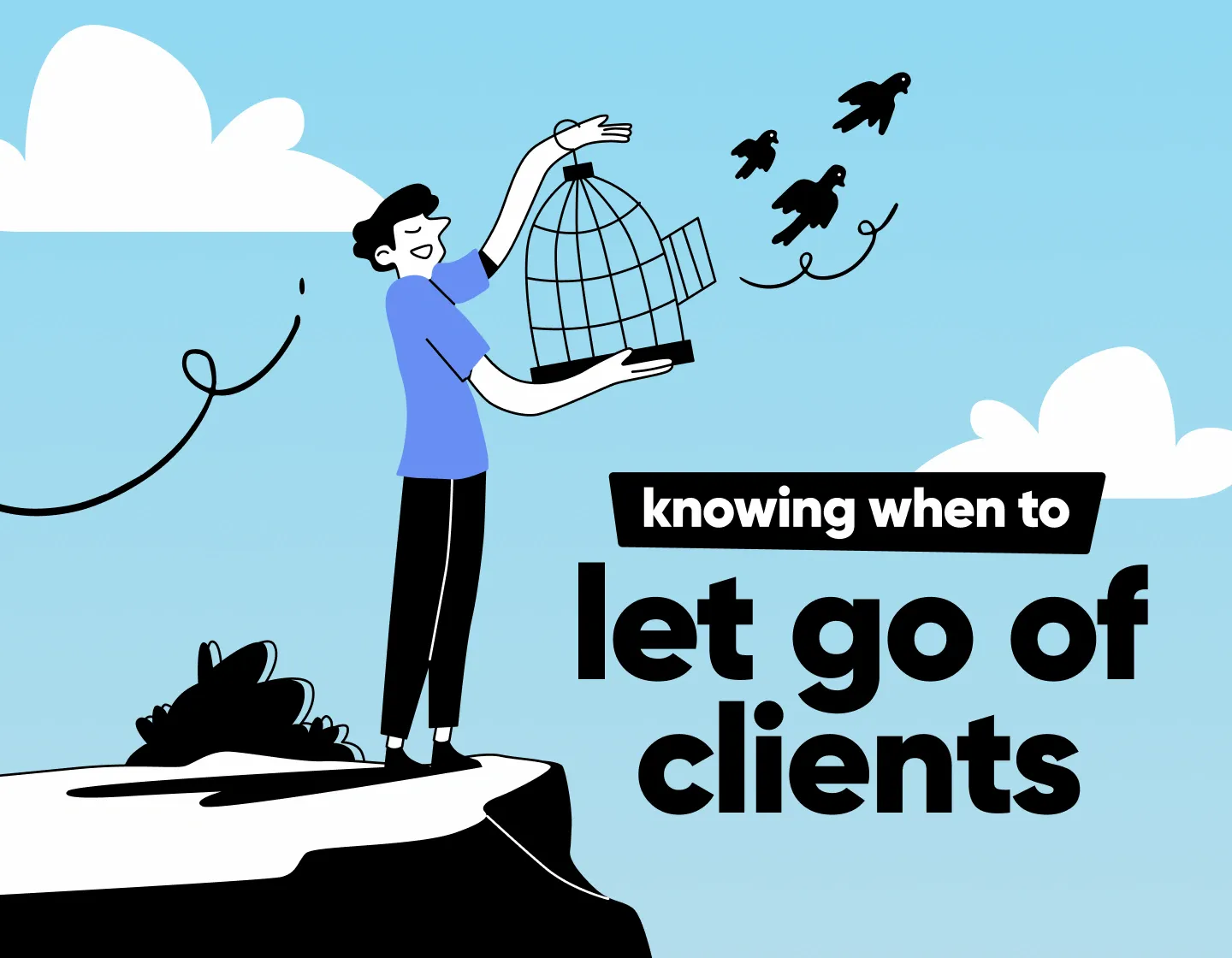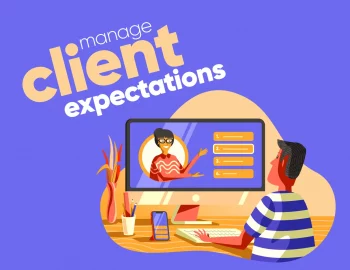Letting go of a client isn’t something most creatives and studio owners do lightly. Especially when you’ve nurtured long-term relationships, supported businesses from their first logo to full-scale rebrands, and genuinely care about your clients’ success. But sometimes, continuing work with a misaligned client costs you far more than it earns.
Walking away from a client doesn’t make you a bad professional, and knowing when to let go is probably one of the most important skills in making smart and brave business decisions. Here’s how to know it’s time:
The signs that it’s time to let a client go
Some signs are loud: late payments, disrespect, blown scopes. Others are quieter, like the tension in your team’s shoulders when that one client pops up in Slack. Either way, these red flags are worth paying attention to.
1. Your team is burned out and avoids their projects
These clients are the energy drainers. And when dealing with such, the signs usually don’t come from the client, but from your own team.
The client might not be rude or reckless, but they leave the team emotionally fried as they often have a hard time articulating what they want. In the meantime, they expect you to read their minds, and you basically end up doing extra rounds, second-guessing your work, and constantly recalibrating.
Look for the internal signs – maybe your best designer asks to be taken off the account. Or maybe you’re the one dragging your feet on replying to their email. Burnout, dread, and creative drought are signals. And when they pile up around a particular client, it’s time to listen. Letting go might not just protect your team’s energy, it might renew their joy from work.
2. They consistently disrespect boundaries around time and communication
The boundary pushers – they know you have limits, they just don’t respect them. Late-night texts. Unrealistic expectations. Last-minute “urgent” revisions – “just this once”. Poor communication. It’s easy to close your eyes the first few times. But when it becomes a pattern, it’s a sign: this client doesn’t respect your process, your team’s time, or the rhythms that allow your studio to thrive.
Boundaries are not barriers. They’re part of what makes your work excellent and sustainable. A client who walks right through them is not just inconvenient, they’re dangerous to your team’s mental health. Protecting your work, team, and calendar isn’t selfish. It’s leadership.
3. They no longer align with your (or your studio’s) vision and values
Your studio has evolved. Your standards are higher, your creative process is sharper, and your mission is clearer than ever. But this one client? They keep pulling you into work that feels off-brand, off-purpose, and frankly, off-putting.
Maybe it’s a brand whose values conflict with your own. Maybe they don’t trust the process and constantly override your direction. Or maybe strategy is overlooked in favor of shiny trends or rushed deliverables, resulting in tension in presenting work because you’re not aligned on what “good” looks like.
If every project feels like a compromise or worse, it’s time to ask whether keeping them is helping or hindering your growth. This kind of misalignment isn’t personal, it’s about chemistry and philosophy. “The misaligned visionaries” often become resource drains, and it’s better to invest these resources in finding new opportunities with clients who are the right fit for your vision.
4. They don’t value the work, and it shows in the budget
Probably every studio has that one client who still pays “freelancer rates” but expects agency-level polish, strategy, and service. Or the one who questions every invoice, resists every price increase, pays late or inconsistently, and acts like they’re doing you a favor by sticking around.
If a client drains more time than their retainer is worth, or worse, makes you feel small about asking to be paid fairly, that’s one boldly waved red flag. Value misalignment shows up in money, tone, and trust. If they don’t see the value, it’s okay to let them find someone they value more. No matter how great the relationship feels, the math has to work.
5. The client demonstrates disrespectful behavior
No creative should have to tolerate disrespect, not in tone, not in attitude, and not in how their ideas or people are treated. It could be subtle: constant micromanaging, dismissive feedback, or power plays in meetings. Or it could be loud: yelling, name-calling, inappropriate comments, or belittling a junior designer in front of the group.
Either way, it’s a sign to stop and go your separate ways. You’ve built a culture of respect. And even one toxic client can eat that up from the inside.
6. You’re saying “No” to better opportunities to keep them happy
Difficult clients take up too many resources. They may demand a lot of your time and energy, leaving you with little to spare for your other clients or business operations, thus leading to neglecting your future growth and even losing clients.
This is the cost we don’t talk about enough. Every yes to an underpaying, draining, or, in general, bad client might be a no to your next dream project. To a client who actually values your work. To a brand that lights your team up instead of taking the soul out of them.
If keeping such clients means turning down new ones who are a better fit (financially, creatively, or culturally), you’re not making a business decision. You’re making a fear-based one. The right clients won’t just pay better. They’ll feel better.
No client needs to tick every box. Even one persistent red flag, especially if it affects your team’s well-being or your business’s integrity, can be reason enough to re-evaluate. The key is to notice the patterns before burnout sets in.
How to end things gracefully and professionally
Ending a client relationship doesn’t have to be messy or dramatic. In fact, when done with intention, it can actually build trust, showing that your studio stands by its values, respects the client, and prioritizes long-term alignment over short-term gain. Here’s a step-by-step approach to offboarding with care and professionalism:
1. Prepare your message with clarity and care
Start by getting clear on why the relationship is ending, not just for the client, but for yourself. Maybe it’s a values mismatch, persistent boundary issues, or simply a shift in capacity or focus.
Let them know that parting ways is a thoughtful decision that’s for both parties’ best interest, and frame it from a values and capacity standpoint. Avoid blame and be kind, but not apologetic. Focus on mutual growth and misalignment, not failure.
“After careful consideration, we’ve realized that our studio isn’t the right long-term fit for your needs. We want to ensure you’re supported, so here’s how we can help you transition.”
2. Choose the right medium
If the client relationship has been primarily digital, a clear, well-written email is totally appropriate. For longer-term clients or those with more emotional investment, consider offering a follow-up call, not to negotiate, but to wrap things up respectfully.
Pro Tip:
Don’t open with redundant details that delay the message. Start with gratitude, clearly state the decision, and then explain the next steps.
3. Set offboarding boundaries and clear expectations
You don’t need to disappear, but you do need to define what you will and won’t do during the transition. So:
- Wrap up unfinished deliverables (if part of your agreement)
- Send over any necessary files or brand assets
- Provide a final invoice and payment deadline
- Define your offboarding date clearly
- Optional: offer a short grace period for minor questions (2-3 weeks max)
Pro Tip:
Do not open the door to “one more quick thing.” That’s how scope zombies come back from the dead.
4. Offer referrals (if it feels appropriate)
If the client isn’t toxic but just misaligned, a sort of softer farewell goes a long way. So what can you do?
- Recommend the services of a trusted freelancer or studio who may be a better fit
- Share a short list of referral options with links and contact info
- If relevant, offer a brief summary for their next creative partner
This shows respect without inviting future scope creep. It also makes you the kind of business people remember fondly (even when things end).
What to tell the team and why it matters
Your team feels the ripple effects of every working relationship, especially the tough ones. When you let a client go, sharing the decision openly (and thoughtfully) reinforces your studio’s values and shows your crew they’re protected, not left guessing.
Be clear, not dramatic. Frame the decision around alignment and energy, not blame, while acknowledging the team’s efforts.
“We’ve decided to part ways with [Client]. The relationship wasn’t sustainable for the team or aligned with how we want to work. I saw how hard you worked to hold the line. Thank you – it meant a lot.”
Finally, create space for feedback. Your team might’ve spotted early warning signs or have advice on how to improve things for the next time.
Even a quick, honest conversation helps the team feel informed, valued, and grounded, turning a tough moment into a trust-building one.
What comes next? Making room for the better-fit clients
Letting go of a bad client relationship is like removing weeds from your creative business’ garden – as you do it, you’re making space for planting the right seeds – new clients who energize your team, pay your rates, and trust your process.
Here are a few ways to call them in:
- Refresh your brand messaging so it can reflect your best work
- Share case studies of aligned, successful projects
- Update your inquiry process to include red flag questions
- Use a client-fit checklist to score leads before they take root
- Re-evaluate your pricing model and adjust your service fees if needed
Bonus #1: 5 quick-check red flags
Here’s a quick checklist you can keep on hand when in doubt whether it’s time to let go of a client:
Even one or two of these showing up consistently? Time for a relationship check.
Bonus #2: Offboarding email template
Polite, professional, and to the point:
Subject: Wrapping Up Our Work Together
Hi [Client Name],
After reviewing our current work and capacity, we’ve decided to step back from this project moving forward. This wasn’t an easy decision, but one made to stay aligned with the direction our studio is heading.
We’re grateful for the work we’ve done together and want to make the transition as smooth as possible. We’ll [list next steps here: share files, final invoice, end date, etc.].
If you’d like, we’re happy to recommend a few creatives who might be a better fit for your next steps.
Thanks again for the opportunity.
[Your Name]
+ Referral script if you’re recommending someone else:
“We’re not the best fit for this phase of your project, but I’d love to recommend [Name] – they’re sharp, strategic, and work with businesses like yours. Want an introduction?”
Keep it short, warm, and optional.
Bottom line?
You are allowed to outgrow a business relationship. You didn’t build your studio just to stay busy – you built it to create meaningful, impactful, high-quality work with people who respect your vision and value your craft. That means making the occasional hard call, including the decision to let go of a client who no longer fits.
It’s not burning a bridge – it’s choosing alignment over obligation. It’s protecting your team, honoring your evolution, and creating space for what’s next, not just what’s familiar.
So if you’re wrestling with this difficult decision, know this: you’re not being disloyal. You’re being discerning. And that’s the kind of leadership that sustains creative businesses and the people inside them, for the long run.






